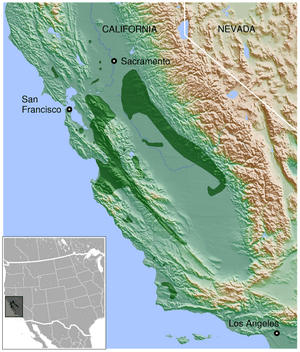California tiger salamander facts for kids
Quick facts for kids California tiger salamander |
|
|---|---|
 |
|
| Conservation status | |
| Scientific classification | |
| Genus: |
Ambystoma
|
| Species: |
californiense
|
 |
|
| California Tiger Salamander range | |
The California tiger salamander (Ambystoma californiense) is a special amphibian that lives only in California. It is considered a vulnerable species, which means it needs protection to survive. This salamander is a type of mole salamander.
Scientists once thought it was a subspecies of the tiger salamander. However, they recently decided it is its own separate species. Some groups of California tiger salamanders are listed as federally endangered. This includes populations in Sonoma County and Santa Barbara County. The Central California group is listed as federally threatened. These groups have been separate for over a million years.
Contents
About the California Tiger Salamander
The California tiger salamander is a fairly large and shy amphibian. It lives only in California. Adult salamanders can grow to be about 7 to 8 inches long. They have a thick body and a wide, rounded snout.
Adults are black with yellow or cream-colored spots. Young salamanders, called larvae, are greenish-grey. The California tiger salamander has brown eyes that stick out a bit, with black centers.
Where They Live and Roam
California tiger salamanders need vernal pools and other seasonal ponds to have their babies. These are temporary pools of water that form after rain. Their homes are usually near large ponds that do not have fish. Fish would eat their eggs and young. They can be found in areas up to 3,200 feet high.
Adult salamanders travel at night from their dry land homes to these wet breeding spots. They start moving with the first big rains of fall and winter. After breeding, they go back to their dry land homes.
Historical and Current Locations
Long ago, California tiger salamanders likely lived in grasslands across much of California. Today, they are found from Sonoma County south to Santa Barbara County. They also live in ponds along the Central Valley. This includes areas from Colusa County to Kern County. They are also in the coastal mountains.
The populations in Sonoma and Santa Barbara counties have been listed as endangered since the early 2000s. In 2004, the US Fish and Wildlife Service listed the Central California group as threatened.
There are six main groups of these salamanders. They are found in Sonoma County, the Bay Area, the Central Valley, the southern San Joaquin Valley, the Central Coast Range, and Santa Barbara County.
Threats to Their Survival
The main reasons California tiger salamander numbers have dropped are:
- Loss of habitat: Their homes are being destroyed.
- Predators: Animals like American bullfrogs eat them.
- Limited access: They can't always reach their breeding ponds.
There is also a problem with Barred Tiger Salamanders (Ambystoma tigrinum mavortium). These are not native to California. They have been breeding with California tiger salamanders for 50 to 60 years. This creates hybrid salamanders.
Their Amazing Lifecycle

Adult salamanders spend most of their lives underground. They use burrows made by other animals, like ground squirrels and gophers. This is because salamanders are not good at digging their own tunnels. We don't know much about what they do underground.
People used to think they went into a deep sleep, like hibernation, during summer. This is called estivation. But researchers have used special cameras to see them actively looking for food underground. Adult salamanders are known to eat earthworms, snails, insects, fish, and even small mammals. However, they eat very little as adults.
How They Reproduce
Breeding happens after the first rains in late fall and early winter. The wet season allows the salamanders to travel to the nearest pond. This journey can be over a mile long and take several days.
The female lays her eggs in small groups or one by one. The eggs hatch after 10 to 14 days. The young, called larvae, live in the water for three to six months. Some larvae may even "overwinter" in the pond. This means they stay in the water through the winter. For these larvae, changing into adults can take 13 months or more.
Larvae eat other small water creatures, including tadpoles. When their pond dries up, they change. They absorb their gills, grow lungs, and then the metamorphs (young adults) leave the pond to find a burrow.
On average, a female salamander breeds about 1.4 times in her life. She produces about 8.5 young that survive to become adults each time she breeds. This means a female might produce around 12 adult offspring in her lifetime. California tiger salamanders can live for up to 15 years.
See also
 In Spanish: Salamandra tigre de California para niños
In Spanish: Salamandra tigre de California para niños



